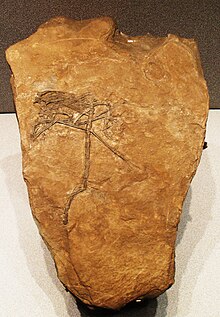Peteinosaurus zambellii
|
Peteinosaurus Temporal range: Late Triassic, 221–210 Ma |
|
|---|---|
 |
|
| Paratype MCSNB 3359 | |
| Scientific classification | |
| Kingdom: | Animalia |
| Phylum: | Chordata |
| Order: | †Pterosauria |
| Clade: | †Eopterosauria |
| Genus: |
†Peteinosaurus Wild, 1978 |
| Species: | †P. zambelli |
| Binomial name | |
|
Peteinosaurus zambelli Wild, 1978 |
|
Peteinosaurus (/pɛˌtaɪnəˈsɔːrəs/ pe-TY-nə-SAWR-əs meaning "winged lizard") was a prehistoric genus of Pterosauria. It lived in the late Triassic period in the late Norian age (about 221 to 210 million years ago).
The genus has been described by the German paleontologist Rupert Wild in 1978. The type species is Peteinosaurus zambellii. The genus name is derived from Greek peteinos, "winged" and sauros, "lizard", the latter being used to indicate any saurian. The specific name, zambellii, honours Rocco Zambelli, the curator of the Bergamo natural history museum.
Peteinosaurus was one of the smallest pterosaurs. Peteinosaurus had a wingspan of around 60 cm (24 in), and its weight was less than that of a common blackbird.
Three fossils have been found near Cene, Italy. The first fossil, the holotype MCSNB 2886, is fragmentary and disarticulated. The second, the articulated paratype MCSNB 3359, lacks any diagnostic features of Peteinosaurus and thus might be a different species. This paratype has a long tail (20 cm) made more stiff by long extensions of the vertebrae; this feature is common among pterosaurs of the Triassic. The third example is MCSNB 3496, another fragmentary skeleton. All specimens are those of subadults and of none has the skull been preserved.
...
Wikipedia
